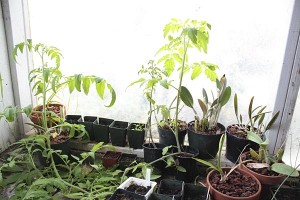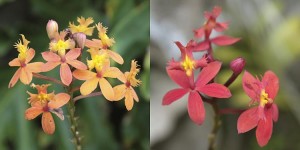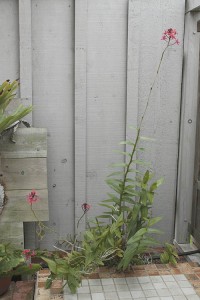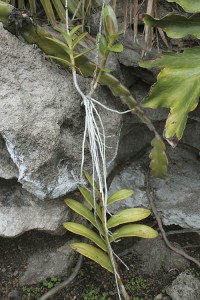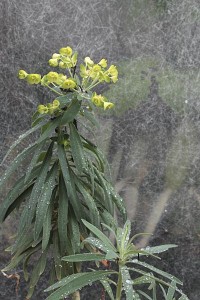 I was in the greenhouse Friday morning, watering some pots of seedlings. It seemed funny for a second, because outside the greenhouse it was raining. If I hadn’t gone in there with the hose that morning, the seedlings would have died in the desert for lack of water.
I was in the greenhouse Friday morning, watering some pots of seedlings. It seemed funny for a second, because outside the greenhouse it was raining. If I hadn’t gone in there with the hose that morning, the seedlings would have died in the desert for lack of water.
(Left, a Euphorbia characias ssp. wulfenii outside the greenhouse, blooming away in the rain.)
I used to grow and breed phalaenopsis orchids in the greenhouse. It was gonzo amounts of work to keep up with repotting hundreds of plants. And trying to concoct an environment that would fool the orchids into thinking that they were in the lowlands of the Philippines instead of the flats of Southern California wasn’t that easy either. In addition to all the work, the greenhouse was an energy pig, taking as much natural gas to heat as the entire house.
So, end of orchid obsession. End of heating the outdoors and wasting all that energy. (The New York Times has a recent piece on a couple who decided to build themselves a greenhouse. Their heater hasn’t arrived yet, but they’re already way over budget.)
Now that the tropical orchid episode of my life has ended the greenhouse is only heated by the sun via the greenhouse effect. At this time of year it’s handy to have a spot that will help give young plants a head start on spring. That’s pretty much how I use the greenhouse now.
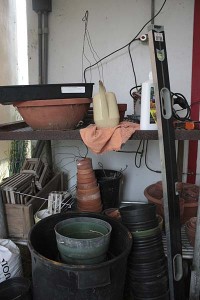 And, um, yes, for a place to store garden clutter. Sort of a garden shed with windows…
And, um, yes, for a place to store garden clutter. Sort of a garden shed with windows…
 Fortunately the windows are an opaque fiberglass, so all the mess inside is obscured. Maybe even a little mysterious and poetic. Here are some potted plants as seen from the outside.
Fortunately the windows are an opaque fiberglass, so all the mess inside is obscured. Maybe even a little mysterious and poetic. Here are some potted plants as seen from the outside.
As I was watering the plants in my little artificial outdoor desert I thought back to the 1980s. One the stories from the news that has stuck in my brain all these years was a report on Michèle Bennett, the wife of Haiti’s dictator, Baby Doc Duvalier. The couple was bad news all around, and one of Michèle’s vices was that she’d refrigerate a part of the palace so that she and her friends could strut about in the fur coats that they collected. (Compared to her husband’s brutal ways, it all seems pretty minor, of course.)
Mink and fox and chinchilla coats in Haiti. About as rational as a greenhouse full of warm tropical orchids in San Diego, I thought.
I guess we all want a little of of what doesn’t come easily or naturally. But in an age of a growing awareness of the need to live greener it’s good to stand back and see what we really need.

